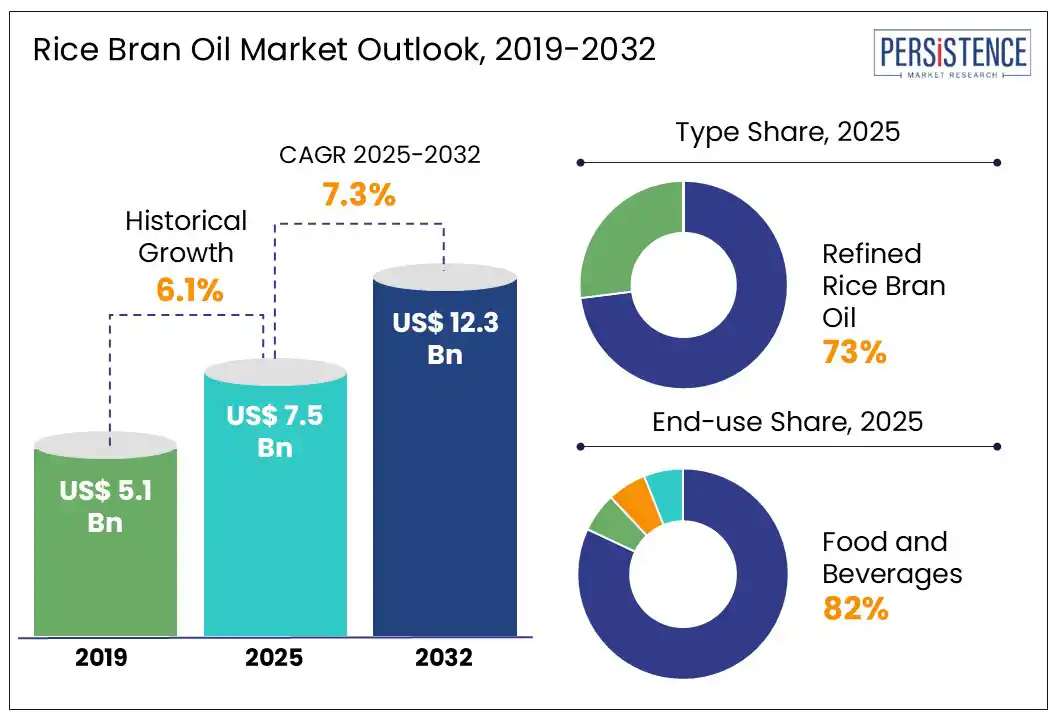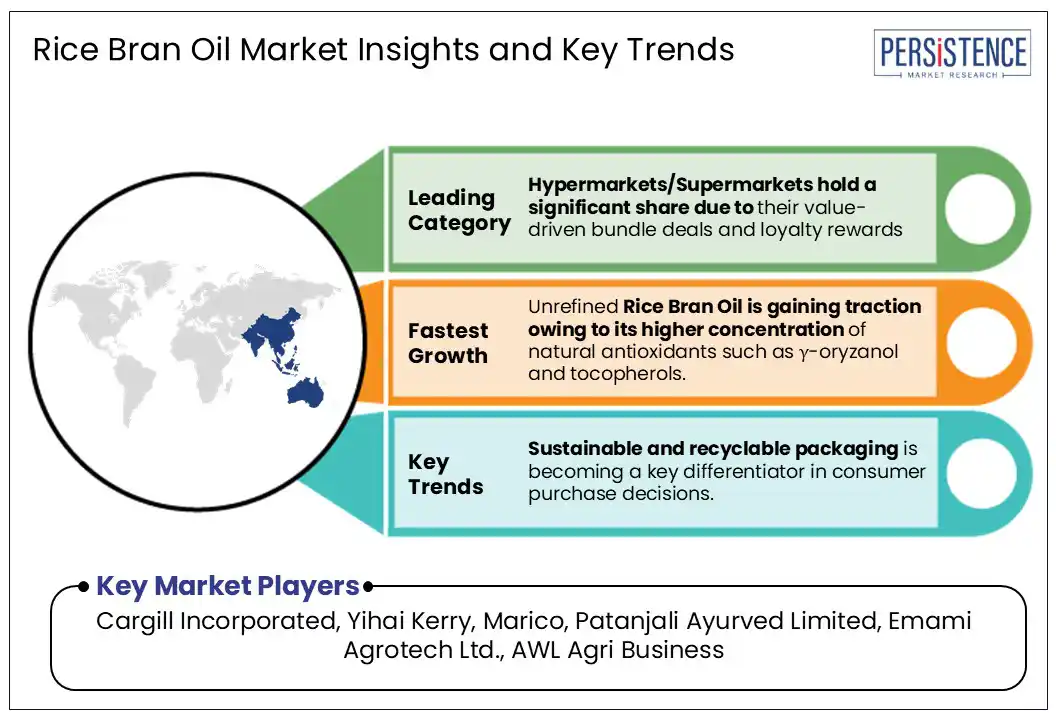ID: PMRREP35053| 199 Pages | 16 Jul 2025 | Format: PDF, Excel, PPT* | Food and Beverages

The global rice bran oil market size is likely to be valued at US$ 7.5 billion in 2025 and is expected to reach US$ 12.3 billion by 2032, growing at a CAGR of 7.3% during the forecast period from 2025 to 2032.
Rice bran oil, extracted from the outer layer of rice grains, is increasingly recognized for its health benefits, including cholesterol reduction and high antioxidant content. Technological advancements in extraction methods and a shift toward plant-based, non-GMO oils are making rice bran oil more accessible and affordable. Its high smoke point and neutral flavor have also expanded its use in food processing, cosmetics, and nutraceuticals, positioning rice bran oil as a versatile and sustainable choice in the edible oil sector. The rice bran oil market is undergoing strategic repositioning as brands leverage fortification, clean-label innovation, and functional health claims to compete against emerging premium oils.

Key Industry Highlights:
|
Global Market Attribute |
Key Insights |
|
Global Rice Bran Oil Market Size (2025E) |
US$ 7.5 Bn |
|
Market Value Forecast (2032F) |
US$ 12.3 Bn |
|
Projected Growth (CAGR 2025 to 2032) |
7.3% |
|
Historical Market Growth (CAGR 2019 to 2024) |
6.1% |
According to the Centers for Disease Control and Prevention (CDC), one person in the U.S. dies every 33 seconds from cardiovascular disease, underscoring a public health crisis. On a global scale, the World Health Organization (WHO) reports that CVDs claim an estimated 17.9 million lives each year, making them the leading cause of death worldwide. These alarming statistics are prompting consumers to reevaluate their dietary habits, especially their choice of cooking oils. Rice bran oil, with its high levels of γ-oryzanol, phytosterols, and vitamin E, is emerging as a preferred option for managing cholesterol and supporting cardiovascular health. Its favorable fatty acid profile and natural antioxidant content are aligning with growing demand for heart-smart nutrition, positioning rice bran oil as a compelling solution in the functional foods and wellness-driven edible oils market.
The rising preference for exotic cooking oils is increasingly diluting consumer demand for rice bran oil, especially in urban and premium food segments. Oils such as avocado, macadamia, and cold-pressed sesame are gaining popularity due to their perceived superior nutritional profiles, gourmet appeal, and association with global culinary trends. As health-conscious consumers become more experimental and brand-savvy, rice bran oil, despite its cholesterol-lowering properties and antioxidant content, often falls short in terms of novelty and positioning. Many consumers view it as a functional, everyday oil rather than a premium or aspirational choice. This shift in consumer mindset is compounded by the aggressive marketing of exotic oils across digital platforms and retail outlets. As a result, rice bran oil risks being overshadowed in the competitive edible oils landscape unless repositioned with stronger branding and targeted differentiation strategies.
Companies operating in the rice bran oil market have a strong opportunity to expand into immunity-focused product lines by leveraging the oil’s inherent bioactive compounds and enhancing them with targeted fortification. With rising consumer awareness around immune health, especially post-pandemic, there is growing demand for functional cooking oils that contribute to daily wellness. Rice bran oil is naturally rich in γ-oryzanol and tocopherol compounds known for their antioxidant and cholesterol-lowering properties, making it an ideal base for immunity-supporting products. By fortifying rice bran oil with essential vitamins such as A, D, and E, companies can position their offerings as everyday health solutions without compromising on taste or versatility.
For instance, Cargill’s Gemini™ Rice Bran Oil brings the benefit of 40% more γ-oryzanol, which supports the reduction of LDL cholesterol. Enriched with antioxidants and fortified with vitamins A, D, and E, the oil is designed for health-conscious consumers seeking both nutrition and culinary performance.
Unrefined Rice Bran Oil is expected to grow at a projected CAGR of 8.5% during the forecast period from 2025 to 2032, driven by rising consumer demand for minimally processed, nutrient-rich oils. Its growing appeal stems from the retention of natural antioxidants such as γ-oryzanol and tocopherols, which are known to support heart health, reduce oxidative stress, and offer anti-inflammatory benefits. Health-conscious consumers increasingly value these compounds, which are often diminished during the refining process. This shift aligns with broader trends toward clean-label and functional food products. Additionally, unrefined rice bran oil is being embraced in premium culinary and nutraceutical applications for its natural composition and authenticity. While refined rice bran oil continues to dominate the global market with over 73% share due to its neutral flavor and stability, the unrefined segment is carving out strong growth in high-value, health-driven niches.
Hypermarkets/Supermarkets hold a substantial share of 38% as of 2024 in the rice bran oil market, primarily due to their ability to offer value-driven bundle deals and well-structured loyalty reward programs. These retail giants attract cost-conscious and bulk-buying consumers by offering competitive pricing, larger packaging options, and promotional discounts that reinforce brand switching and repeat purchases. The physical presence of products on shelves, along with strategic end-cap placements, further amplifies visibility and consumer trust. Moreover, supermarkets often feature private-label rice bran oils, adding affordability without compromising perceived quality. While this channel dominates offline sales, online retail is growing steadily, particularly among health-aware urban buyers seeking convenience and variety. Additionally, B2B sales of refined rice bran oil are rising, driven by demand from food processors, institutional kitchens, and HORECA sectors that prioritize neutral flavor, extended shelf life, and nutritional value.

North America is expected to achieve a 7.8% CAGR during the forecast period, 2025 to 2032, driven by evolving consumer preferences and industry diversification. In the U.S., rising health awareness is fueling demand for rice bran oil due to its perceived cholesterol-lowering and heart health benefits, especially among aging and health-conscious populations. The U.S. is also witnessing increased product innovation, with brands like Via Natural incorporating rice bran oil into skincare and haircare products for its antioxidant and emollient properties. The market is further supported by the expansion of rice bran oil applications into pharmaceuticals and functional food formulations. Canada is emerging as a niche market, with growing imports of refined rice bran oil from key producers such as India and Thailand. In both the U.S. and Canada, clean-label trends and plant-based wellness are reinforcing long-term growth momentum.
Europe is evolving steadily, driven by rising demand for plant-based, sustainable, and allergen-free oils in both culinary and non-food sectors. In Germany and France, rice bran oil is gaining traction in premium food formulations due to its mild flavor, oxidative stability, and clean-label positioning. The UK is seeing increased usage of rice bran oil in organic and vegan bakery products as a replacement for hydrogenated oils. Additionally, niche cosmetic brands across Europe are formulating with rice bran oil for its high content of γ-oryzanol and vitamin E, supporting anti-aging and skin-repair claims. With a growing preference for locally sourced, traceable ingredients, European importers are partnering with sustainable suppliers in Asia.
Asia Pacific is likely to account for a significant share of 77% as of 2025, driven by its large rice cultivation base and deep-rooted consumption habits. Countries such as India, China, Thailand, and Vietnam are central to both production and demand. India is witnessing strong momentum, supported by government-backed initiatives like NAFED’s launch of fortified rice bran oil, aimed at improving public health and aligning with the Aatmnirbhar Bharat vision. This is expected to create new growth avenues for domestic edible oil manufacturers focused on nutrition and self-sufficiency. China plays a dual role, both as a major consumer and as a technology hub, with key players like Henan Huatai Cereals and Oils Machinery Co., Ltd. advancing oil extraction infrastructure. Growing consumer preference for heart-healthy, functional oils continues to fuel innovation in Japan, South Korea, and Southeast Asia.
The competitive nature of the global rice bran oil market is intensifying as companies differentiate through innovation, sustainability, and value-added offerings. Many players are catering to the growing demand for clean-label and natural products by launching organic and cold-pressed variants. To capture emerging non-food opportunities, manufacturers are expanding into cosmetics, personal care, and nutraceuticals with specialized, high-grade formulations. Backward integration strategies such as acquiring or partnering with rice milling operations, are enhancing supply chain control and cost efficiency. To align with shifting consumer and regulatory expectations, brands are increasingly adopting sustainable packaging and transparent labeling practices. An omnichannel distribution strategy, combining e-commerce, retail, and B2B platforms, supports deeper market penetration. Expansion into Western markets and fortification efforts targeting preventive health segments further strengthen brand positioning. Celebrity-led campaigns are also being used to drive awareness, while investments in production facilities reflect long-term competitive intent.
The Rice Bran Oil market is projected to be valued at US$7.5 Bn in 2025.
The surge in cardiovascular diseases is driving interest in heart-healthy rice bran oil.
The Rice Bran Oil market is poised to witness a CAGR of 7.3% between 2025 and 2032.
Companies can expand in immunity-focused product lines is the key market opportunity.
Major players in the Rice Bran Oil market include Cargill, Incorporated, Yihai Kerry, Marico, Patanjali Ayurved Limited, Emami Agrotech Ltd., AWL Agri Business, and others
|
Report Attribute |
Details |
|
Historical Data/Actuals |
2019 - 2024 |
|
Forecast Period |
2025 - 2032 |
|
Market Analysis |
Value: US$ Bn, Volume: Tons |
|
Geographical Coverage |
|
|
Segmental Coverage |
|
|
Competitive Analysis |
|
|
Report Highlights |
|
|
Customization and Pricing |
Available upon request |
By Product Type
By End-use
By Distribution Channel
By Region
Delivery Timelines
For more information on this report and its delivery timelines please get in touch with our sales team.
About Author